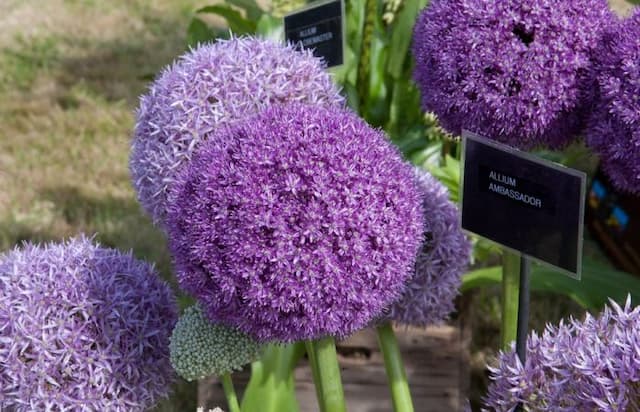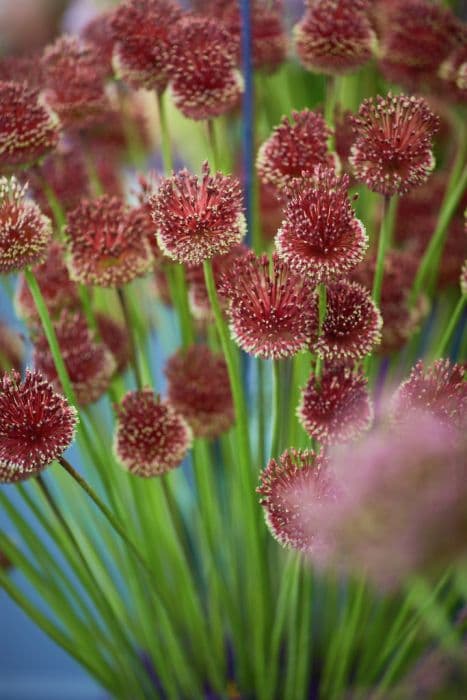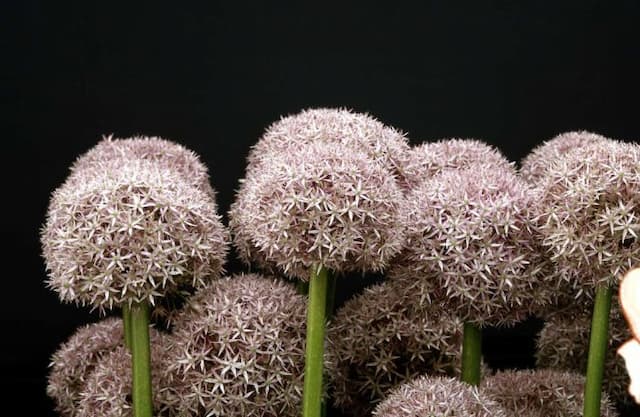Ornamental Onion Allium 'Mont Blanc'

ABOUT
Allium 'Mont Blanc' is an ornamental plant notable for its showy, spherical flower heads that are composed of numerous small, star-shaped flowers. These blooms are typically a pure, snowy white, which is where the name 'Mont Blanc' likely draws its inspiration, referencing the famous snow-capped mountain in the Alps. The flowers grow in clusters that form tight, globe-like shapes, providing a striking visual impact in the garden with their dense floral arrangement. The foliage of Allium 'Mont Blanc' consists of long, slender, and glossy green leaves. These leaves often have a linear or strap-shaped appearance and can blend into the background, allowing the dramatic flowers to take center stage. Prior to the flowering period, the foliage provides an attractive verdant backdrop. After the blooms have spent their season, the greenery typically dies back. The overall look of Allium 'Mont Blanc' is one of architectural elegance, with the flower stems rising above the foliage and culminating in the large, round flower heads. The plant is cherished by gardeners for its striking appearance, with the white flowers often creating a contrast against the surrounding greenery or complementing other plants within a garden design. It has a somewhat stiff and upright bearing that allows it to mix well among a variety of garden plants. The elegance and simplicity of Allium 'Mont Blanc' make it a popular choice for gardeners looking to add both visual structure and a touch of sophistication to their plantings. The white blooms can also serve as a serene focal point in floral arrangements and borders.
About this plant
 Names
NamesFamily
Amaryllidaceae
Synonyms
Giant White Allium, Ornamental Onion, Mont Blanc Allium
Common names
Allium 'Mont Blanc'.
 Toxicity
ToxicityTo humans
The Allium 'Mont Blanc', commonly known as ornamental onion, is not considered highly toxic to humans. However, ingesting large quantities of the bulbs might cause gastrointestinal discomfort, nausea, vomiting, or diarrhea. It is generally safe to handle the plant, but consuming it in significant amounts is not advisable.
To pets
Ornamental onion is toxic to pets, especially cats and dogs. If ingested, it can cause symptoms such as nausea, vomiting, abdominal pain, and diarrhea. In more severe cases, it can lead to drooling, lethargy, and at high enough doses, can result in damage to red blood cells, leading to anemia. It is crucial to prevent pets from ingesting any part of this plant.
 Characteristics
CharacteristicsLife cycle
Perennials
Foliage type
Deciduous
Color of leaves
Green
Flower color
White
Height
3 feet (0.91 meters)
Spread
1 foot (0.30 meters)
Plant type
Bulb
Hardiness zones
4
Native area
Asia
Benefits
 General Benefits
General Benefits- Attracts pollinators: Allium 'Mont Blanc', commonly known as ornamental onion, is known to attract bees and other beneficial pollinators to the garden, which assists in the pollination of nearby plants.
- Easy to grow: This plant is low maintenance and can thrive in a variety of soil conditions, making it an easy addition for many gardeners.
- Drought tolerant: Once established, Allium 'Mont Blanc' can withstand periods of dry weather, reducing the need for frequent watering.
- Adds height and structure: With its tall stems and spherical blooms, it can add vertical interest and architectural structure to garden beds and borders.
- Deer and rodent resistant: The plant is generally resistant to deer and rodents, making it a good choice for areas where these animals are a problem.
- Long-lasting blooms: The flowers have a lengthy blooming period in late spring to early summer and can also be used as cut flowers in bouquets.
- Seasonal interest: After the flowers fade, the seed heads provide continued visual interest throughout the summer and into the fall.
- Companion planting: Allium 'Mont Blanc' can be planted among other perennials that will hide their foliage as it dies back, offering a seamless integration in the garden.
 Medical Properties
Medical PropertiesThis plant is not used for medical purposes.
 Air-purifying Qualities
Air-purifying QualitiesThis plant is not specifically known for air purifying qualities.
 Other Uses
Other Uses- Culinary garnish: The tall and impressive flower stalks of Allium 'Mont Blanc' can be used to add a decorative touch to gourmet dishes or platters.
- Photography: The striking white blooms serve as excellent subjects for macro photography, capturing the intricate details of the flowers.
- Textile Dye: Although not common, the plant material could theoretically be used as a natural dye for fabric, producing subtle color variations.
- Floral Water: Blooms can be soaked in water to create a floral-scented water that can be used for bath rituals or as a linen spray.
- Companion Planting: Their strong scent and tall stature can help detract pests from more susceptible companion plants in a mixed border or vegetable garden.
- Drying and Potpourri: The flowers can be dried and included in potpourri mixes for a nature-inspired scent in your home.
- Education and Demonstration: These ornamental onions can be used in educational settings to demonstrate bulb growth and pollination to students.
- Wedding Decor: They can be a unique choice for wedding bouquets or centerpieces, particularly for a white-themed wedding.
- Crafting: The sturdy stems and seed heads can be used in the creation of natural crafts, like wreaths or dried flower arrangements.
- Long-term Preservation: The seed heads of Allium 'Mont Blanc' can be preserved using glycerin or silica gel for lasting decorative elements.
Interesting Facts
 Feng Shui
Feng ShuiThe ornamental onion is not used in Feng Shui practice.
 Zodiac Sign Compitability
Zodiac Sign CompitabilityThe ornamental onion is not used in astrology practice.
 Plant Symbolism
Plant Symbolism- Unity: Allium flowers, due to their spherical shape, are often seen as a symbol of unity, representing the coming together of many different parts to make a whole.
- Purity: The 'Mont Blanc' allium, with its pure white blooms, is commonly associated with purity and innocence, reminiscent of its snowy namesake, Mont Blanc in the Alps.
- Prosperity and Success: In some cultures, alliums are thought to bring luck in prosperity and success, perhaps due to their robust nature and impressive height.
- Good Fortune: Giving alliums, like the 'Mont Blanc', can be interpreted as a wish for good luck and fortune to the recipient.
- Strength and Patience: The sturdy stalks of the Allium 'Mont Blanc' stand tall and firm, often symbolizing strength and the patience to grow and flourish over time.
 Water
WaterThe Giant Allium, or Allium 'Mont Blanc', should be watered thoroughly during its growing season, ensuring the soil is moist but not waterlogged. Typically, watering once a week with about 0.5 gallons of water per plant is adequate, depending on the soil type and weather conditions. Once the flowering has finished and the foliage begins to yellow, watering can be reduced as the plant goes dormant. Over the fall and winter, water sparingly, only to prevent the soil from completely drying out.
 Light
LightThe Giant Allium thrives in full sun, which means it requires at least 6 hours of direct sunlight daily. The ideal location would provide unfiltered sunlight for the majority of the day, enhancing the plant's growth and blooming capability. Avoid planting in shaded areas, as too little light can lead to poor flowering and elongated, weak stems.
 Temperature
TemperatureGiant Alliums are hardy and can survive in a temperature range, withstanding cold down to about 0°F and tolerating heat as temperatures rise. They prefer a moderate climate, with ideal growing temperatures ranging between 60°F and 70°F, which encourages proper growth and flowering. Extreme heat or cold outside of this range may affect the plant's health and blooming.
 Pruning
PruningPruning Giant Allium is not regularly required, but deadheading, or removing spent flower heads, can be done after blooming to maintain a neat appearance. Cutting back the foliage should be avoided until it has died down naturally, usually by late summer, as the leaves provide energy to the bulb for the next year's growth. The best time for any pruning is after the leaves have yellowed and withered.
 Cleaning
CleaningAs needed
 Soil
SoilThe Mont Blanc ornamental onion prefers well-draining soil with a pH range from 6.0 to 7.5. A mixture of loamy soil enriched with compost or well-rotted manure will provide the nutrients it needs for optimal growth.
 Repotting
RepottingOrnamental onions like Mont Blanc generally do not require frequent repotting. They can be left undisturbed for several years and should only be repotted when they are visibly overcrowded, typically every 3-4 years.
 Humidity & Misting
Humidity & MistingOrnamental onions such as Mont Blanc are typically tolerant of a wide range of humidity levels and do not require any specific humidity conditions, making them versatile and easy to grow in various outdoor climates.
 Suitable locations
Suitable locationsIndoor
Place in bright light, well-drained soil; limit watering.
Outdoor
Plant in full sun, well-drained soil, space 6-8 inches apart.
Hardiness zone
4-9 USDA
 Life cycle
Life cycleThe life of the Allium 'Mont Blanc', commonly known as ornamental onion, begins with seed germination, which occurs in damp, well-drained soil in spring or sometimes by planting bulbs in autumn. After sprouting, the plant develops a rosette of basal leaves, and as it matures, it develops a sturdy stem. The growth phase continues as the foliage thickens, and the plant prepares to flower. Flowering typically occurs in late spring to early summer, when Allium 'Mont Blanc' produces large, spherical, white flower heads that rise on tall stalks above the foliage. After pollination, possibly by bees or other insects, the flowers produce seed capsules, which eventually dry out and release seeds for dispersal. The plant then withers, and the bulb goes dormant over winter, concluding the annual cycle and preparing to emerge again the following spring.
 Propogation
PropogationPropogation time
Spring to early summer
Allium 'Mont Blanc', commonly known as ornamental onion, is typically propagated by dividing the bulbs. The best time for this is after the foliage has died back, usually in late summer to early fall. To propagate, carefully lift the clump of bulbs from the ground using a garden fork, taking care not to damage them. Gently separate the individual bulbs from the clump, each with a portion of the basal plate— the area where the roots grow—intact. Replant these bulbs immediately at a depth three times the height of the bulb, spaced about 8 inches (20 centimeters) apart to allow for adequate growing room. Water the newly planted bulbs thoroughly to settle the soil around them and to help initiate root growth before the cold winter months set in.









